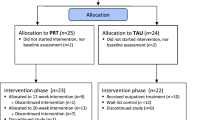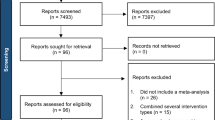Abstract
Background
Pivotal response treatment (PRT) is suggested to be an effective treatment for children with autism spectrum disorder (ASD).
Objectives
We aimed to compile evidence examining the effectiveness of PRT on social communication, social interaction, and repetitive behavior for children with ASD.
Methods
We performed a systematic and comprehensive search for relevant trials about PRT. The results are summarized quantitatively and qualitatively.
Results
We included five randomized controlled trials suggesting that PRT may have positive effects on expressive language (SMD = 0.48; 95% CI 0.04 to 0.93), social interaction (SMD = 1.12; 95% CI 0.50 to 1.74), and repetitive behavior (SMD = 15.97; 95% CI 11.57 to 20.36). The effect on other outcomes, receptive language, and early learning skills is more uncertain. The quality of the evidence was found to be low.
Author’s Conclusions
PRT may be associated with advantageous effects, but more high-quality research is needed before we can draw firm conclusions.





Similar content being viewed by others
References
American Psychiatric Association. (2013). Diagnostic and statistical manual of mental disorders (DSM-5®). American Psychiatric Pub.
Boudreau, A. M., Corkum, P., Meko, K., & Smith, I. M. (2015). Peer-mediated pivotal response treatment for young children with autism spectrum disorders: a systematic review. Canadian Journal of School Psychology, 30(3), 218–235.
Bozkus Genc, G., & Vuran, S. (2013). Examination of studies targeting social skills with pivotal response treatment. Educational Sciences: Theory and Practice, 13(3), 1730–1742.
Bryson, S. E., Koegel, L. K., Koegel, R. L., Openden, D., Smith, I. M., & Nefdt, N. (2007). Large scale dissemination and community implementation of pivotal response treatment: program description and preliminary data. Research & Practice for Persons with Severe Disabilities, 32(2).
Cadogan, S., & McCrimmon, A. W. (2015). Pivotal response treatment for children with autism spectrum disorder: a systematic review of research quality. Developmental Neurorehabilitation, 18(2), 137–144.
Campbell, C. A., Davarya, S., Elsabbagh, M., Madden, L., & Fombonne, E. (2011). Prevalence and the controversy. In International handbook of autism and pervasive developmental disorders (pp. 25–35). Springer.
Deeks, J. J., Higgins, J. P., & Altman, D. G. (2008). Analysing data and undertaking meta-analyses. Cochrane Handbook for Systematic Reviews of Interventions: Cochrane Book Series (pp. 243–296).
Eldevik, S., Hastings, R. P., Hughes, J. C., Jahr, E., Eikeseth, S., & Cross, S. (2009). Meta-analysis of early intensive behavioral intervention for children with autism. Journal of Clinical Child & Adolescent Psychology, 38(3), 439–450.
Elsabbagh, M., Divan, G., Koh, Y.-J., Kim, Y. S., Kauchali, S., Marcín, C., … Wang, C. (2012). Global prevalence of autism and other pervasive developmental disorders. Autism Research, 5(3), 160–179.
GRADEpro. (2014). GRADEpro (Version 29.04.15). Hamilton, Ontario: McMaster University.
Hardan, A. Y., Gengoux, G. W., Berquist, K. L., Libove, R. A., Ardel, C. M., Phillips, J., … Minjarez, M. B. (2015). A randomized controlled trial of pivotal response treatment group for parents of children with autism. Journal of Child Psychology and Psychiatry, 56(8), 884–892.
Higgins, J. P., & Altman, D. G. (2008). Assessing risk of bias in included studies. Cochrane Handbook for Systematic Reviews of Interventions: Cochrane Book Series (pp. 187–241).
Higgins, J. P., & Green, S. (2011). Cochrane Handbook for Systematic Reviews of Interventions (5.1.0). The Cochrane collaboration.
Howlin, P., Magiati, I., & Charman, T. (2009). Systematic review of early intensive behavioral interventions for children with autism. American Journal on Intellectual and Developmental Disabilities, 114(1), 23–41.
Ingersoll, B. (2012). Brief report: effect of a focused imitation intervention on social functioning in children with autism. Journal of Autism and Developmental Disorders, 42(8), 1768–1773.
Irwin, J. K., MacSween, J., & Kerns, K. A. (2011). History and evolution of the autism spectrum disorders. In International handbook of autism and pervasive developmental disorders (pp. 3–16). Springer.
Kasari, C., Gulsrud, A. C., Wong, C., Kwon, S., & Locke, J. (2010). Randomized controlled caregiver mediated joint engagement intervention for toddlers with autism. Journal of Autism and Developmental Disorders, 40(9), 1045–1056.
Khanna, R., Madhavan, S. S., Smith, M. J., Patrick, J. H., Tworek, C., & Becker-Cottrill, B. (2011). Assessment of health-related quality of life among primary caregivers of children with autism spectrum disorders. Journal of Autism and Developmental Disorders, 41(9), 1214–1227.
Koegel, R. L., & Koegel, L. K. (2012). The PRT pocket guide. Baltimoore, MD: Brooks Publishing Company.
Kuhlthau, K., Orlich, F., Hall, T. A., Sikora, D., Kovacs, E. A., Delahaye, J., & Clemons, T. E. (2010). Health-related quality of life in children with autism spectrum disorders: results from the autism treatment network. Journal of Autism and Developmental Disorders, 40(6), 721–729.
Lee, L.-C., Harrington, R. A., Louie, B. B., & Newschaffer, C. J. (2008). Children with autism: quality of life and parental concerns. Journal of Autism and Developmental Disorders, 38(6), 1147–1160.
Makrygianni, M. K., & Reed, P. (2010). A meta-analytic review of the effectiveness of behavioural early intervention programs for children with autistic spectrum disorders. Research in Autism Spectrum Disorders, 4(4), 577–593.
Masi, A., Lampit, A., Glozier, N., Hickie, I., & Guastella, A. (2015). Predictors of placebo response in pharmacological and dietary supplement treatment trials in pediatric autism spectrum disorder: a meta-analysis. Translational Psychiatry, 5(9), e640.
McGowan, J., Sampson, M., Salzwedel, D. M., Cogo, E., Foerster, V., & Lefebvre, C. (2016). PRESS peer review of electronic search strategies: 2015 guideline statement. Journal of Clinical Epidemiology, 75, 40–46.
Mohammadzaheri, F., Koegel, L. K., Rezaee, M., & Rafiee, S. M. (2014). A randomized clinical trial comparison between pivotal response treatment (PRT) and structured applied behavior analysis (ABA) intervention for children with autism. Journal of Autism and Developmental Disorders, 44(11), 2769–2777.
Mohammadzaheri, F., Koegel, L. K., Rezaei, M., & Bakhshi, E. (2015). A randomized clinical trial comparison between pivotal response treatment (PRT) and adult-driven applied behavior analysis (ABA) intervention on disruptive behaviors in public school children with autism. Journal of Autism and Developmental Disorders, 45(9), 2899–2907.
Moher, D., Liberati, A., Tetzlaff, J., & Altman, D. G. (2009). Preferred reporting items for systematic reviews and meta-analyses: the PRISMA statement. Annals of Internal Medicine, 151(4), 264–269.
National Standards Project. (2009). National Standards Project. Randolph, MA.
Nefdt, N. (2007). The use of a self-directed learning program to provide introductory training to parents of children with autism.
Nefdt, N., Koegel, R., Singer, G., & Gerber, M. (2010). The use of a self-directed learning program to provide introductory training in pivotal response treatment to parents of children with autism. Journal of Positive Behavior Interventions, 12(1), 23–32.
Oono, I. P., Honey, E. J., & McConachie, H. (2013). Parent-mediated early intervention for young children with autism spectrum disorders (ASD). Evidence-Based Child Health: A Cochrane Review Journal, 8(6), 2380–2479.
Openden, D. A. (2005). Pivotal response treatment for multiple families of children with autism: probable efficacy and effectiveness of a group parent education workshop.
Pildal, J., Hrobjartsson, A., Jørgensen, K., Hilden, J., Altman, D., & Gøtzsche, P. (2007). Impact of allocation concealment on conclusions drawn from meta-analyses of randomized trials. International Journal of Epidemiology, 36(4), 847–857.
Reichow, B., & Wolery, M. (2009). Comprehensive synthesis of early intensive behavioral interventions for young children with autism based on the UCLA young autism project model. Journal of Autism and Developmental Disorders, 39(1), 23.
Reichow, B., Barton, E. E., Boyd, B. A., & Hume, K. (2012). Early intensive behavioral intervention (EIBI) for young children with autism spectrum disorders (ASD). Cochrane Database of Systematic Reviews, 10.
Reichow, B., Hume, K., Barton, E. E., & Boyd, B. A. (2018). Early intensive behavioral intervention (EIBI) for young children with autism spectrum disorders (ASD). Cochrane Database of Systematic Reviews, 5.
Rispoli, M., Neely, L., Lang, R., & Ganz, J. (2011). Training paraprofessionals to implement interventions for people autism spectrum disorders: a systematic review. Developmental Neurorehabilitation, 14(6), 378–388.
Rogers, S. J., Estes, A., Lord, C., Vismara, L., Winter, J., Fitzpatrick, A., … Dawson, G. (2012). Effects of a brief Early Start Denver Model (ESDM)–based parent intervention on toddlers at risk for autism spectrum disorders: a randomized controlled trial. Journal of the American Academy of Child & Adolescent Psychiatry, 51(10), 1052–1065.
Ryan, R., Hill, S., Broclain, D., Horey, D., Oliver, S., Prictor, M., & Consumers, C. (2007). Study quality guide. Cochrane Consumers and Communication Review Group March.
Schreibman, L., & Stahmer, A. C. (2014). A randomized trial comparison of the effects of verbal and pictorial naturalistic communication strategies on spoken language for young children with autism. Journal of Autism and Developmental Disorders, 44(5), 1244–1251.
Schreibman, L., Dawson, G., Stahmer, A. C., Landa, R., Rogers, S. J., McGee, G. G., … Bruinsma, Y. (2015). Naturalistic developmental behavioral interventions: empirically validated treatments for autism spectrum disorder. Journal of Autism and Developmental Disorders, 45(8), 2411–2428.
Schultz, T. R., Schmidt, C. T., & Stichter, J. P. (2011). A review of parent education programs for parents of children with autism spectrum disorders. Focus on Autism and Other Developmental Disabilities, 26(2), 96–104.
Schulz, K. F., Chalmers, I., Hayes, R. J., & Altman, D. G. (1995). Empirical evidence of bias: dimensions of methodological quality associated with estimates of treatment effects in controlled trials. Jama, 273(5), 408–412.
Schünemann, H. J., Oxman, A. D., Vist, G. E., Higgins, J. P., Deeks, J. J., Glasziou, P., & Guyatt, G. H. (2008). Interpreting results and drawing conclusions. Cochrane Handbook for Systematic Reviews of Interventions: Cochrane Book Series (pp. 359–387).
Sisavath, J. (2014). A review of parent training interventions for children with autism spectrum disorder and proposed guidelines for choosing best practices.
Smith, I. M., Flanagan, H. E., Garon, N., & Bryson, S. E. (2015). Effectiveness of community-based early intervention based on pivotal response treatment. Journal of Autism and Developmental Disorders, 45(6), 1858–1872.
Suhrheinrich, J. (2015). A sustainable model for training teachers to use pivotal response training. Autism, 19(6), 713–723.
Verschuur, R., Didden, R., Lang, R., Sigafoos, J., & Huskens, B. (2014). Pivotal response treatment for children with autism spectrum disorders: a systematic review. Review Journal of Autism and Developmental Disorders, 1(1), 34–61.
Virués-Ortega, J. (2010). Applied behavior analytic intervention for autism in early childhood: meta-analysis, meta-regression and dose–response meta-analysis of multiple outcomes. Clinical Psychology Review, 30(4), 387–399.
Wong, C., Odom, S. L., Hume, K. A., Cox, A. W., Fettig, A., Kucharczyk, S., … Schultz, T. R. (2015). Evidence-based practices for children, youth, and young adults with autism spectrum disorder: a comprehensive review. Journal of Autism and Developmental Disorders, 45(7), 1951–1966.
Wood, L., Egger, M., Gluud, L. L., Schulz, K. F., Jüni, P., Altman, D. G., … Sterne, J. A. (2008). Empirical evidence of bias in treatment effect estimates in controlled trials with different interventions and outcomes: meta-epidemiological study. BMJ, 336(7644), 601–605.
Acknowledgments
This systematic review is a result of the first author’s master thesis at the Center for Evidence-Based Practice, Faculty of Health and Social Sciences, Western Norway University of Applied Sciences, Bergen, Norway. We gratefully thanks for supplementary information from authors, included in this review. Last, we thank the support and feedbacks from colleagues and friends in our work.
Author information
Authors and Affiliations
Contributions
HNO All parts.
KL Screening of records, assessment of risk of bias, helped to drafted the introduction and discussion of the manuscript.
LVN Quality of search, assessment of risk of bias, and helped to drafted the manuscript.
KGB Assessment of risk of bias, overall quality (GRADE), and helped to drafted the results and discussion of the manuscript.
All authors read and approved the final manuscript.
Corresponding author
Ethics declarations
Conflict of Interest
The author declares that there is no conflict of interest.
Ethical Approval
This article does not contain any studies with human participants or animals performed by any of the authors.
Additional information
Publisher’s Note
Springer Nature remains neutral with regard to jurisdictional claims in published maps and institutional affiliations.
Rights and permissions
About this article
Cite this article
Ona, H.N., Larsen, K., Nordheim, L.V. et al. Effects of Pivotal Response Treatment (PRT) for Children with Autism Spectrum Disorders (ASD): a Systematic Review. Rev J Autism Dev Disord 7, 78–90 (2020). https://doi.org/10.1007/s40489-019-00180-z
Received:
Accepted:
Published:
Issue Date:
DOI: https://doi.org/10.1007/s40489-019-00180-z




